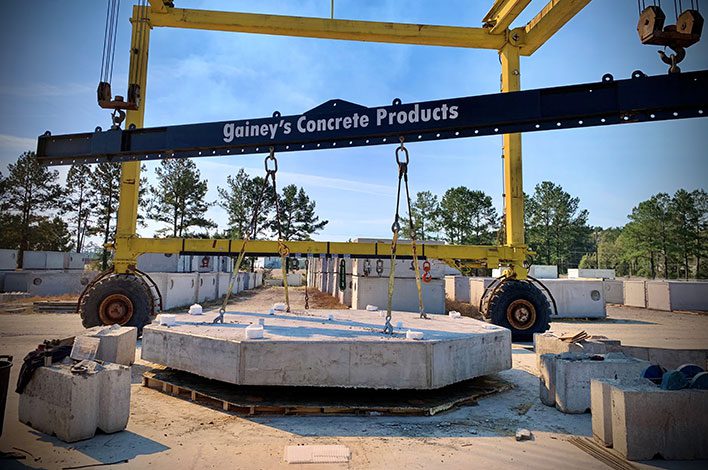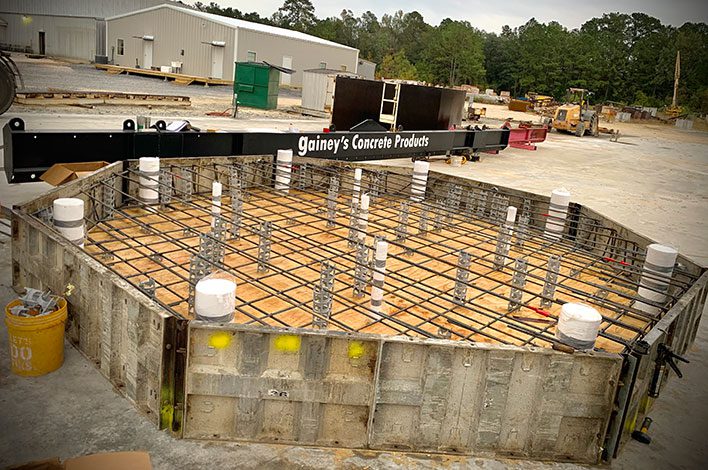Gainey’s manufactures two large octagonal precast slabs to replace existing cast-in-place storage tank foundation for a chemical plant.
Time is money for chemical manufacturers, which have to balance throughput with regular shutdowns for safety, preventative maintenance, upgrades, repairs and compliance. And while shutdowns are an important part of a plant’s efficient and safe operations, the actual shutdown timeframes can affect those organizations’ productivity and bottom lines. Production halts can translate into lost revenue and missed deadlines, and they require the right combination of personnel, equipment and materials.
When one large chemical plant in Louisiana decided to shut down a portion of its plant to replace a cast-in-place chemical storage tank, it called on engineer Elias Henri Hage, PE, CSA department manager at Hunt, Guillot & Associates, for help designing the new structure. Hage says the company wanted to put in a new tank with a different configuration and the replacement structure required a brand-new foundation.
The timing for the project was a tight two to three weeks from start to finish to avoid any extension of the plant’s shutdown time. Hage says cast-in-place wasn’t an option because it would require too much prep, curing and testing time. Besides, he said, “whenever we can specify precast concrete on projects, we do.”
Once precast was selected as the material of choice, Gainey’s of Holden, La., was hired to manufacture the octagonal foundations.
“They wanted to replace the foundations quickly during a planned shutdown of that section of the plant,” says Tim Sander, vice president of operations at Gainey’s. “It was important that they trusted us to have the precast structures complete and correct when they were ready for them.”
For this project, Gainey’s was asked to supply two octagonal foundations, each of which had a surface area of about 260 square feet, required about 16 cubic yards of concrete and weighed more than 66,000 pounds. Since the chemical manufacturer had to stop production in that section of the chemical plant to replace the foundations, the speed of installing premade precast foundations made it a very attractive solution.
Instead of removing the existing ring wall, the company was able to place the new, precast octagonal slab on top of that ring wall.
“This was a much more economical strategy than bringing in special forms, erecting them on a site where there are no flat surfaces and then shipping in the rebar separately,” said Hage, who came up with the idea to bypass those issues and use precast instead. “If we hadn’t been able to use precast, the plant would have lost another two weeks of downtime. In the long run, this was a much more economical choice.”
During installation, the contractor removed the old tank, placed the new, 18-inch slab and put the new tank on top of it. The tank was then anchored to the new, octagonal concrete slab.
“Our structures were ready, exceeded design strength and fit precisely into place,” Sander said. “That way, the chemical plant was able to minimize production downtime.”
Getting it Done in a Short Timespan
Gainey’s Senior Design Manager Cyndi Glascock understands the challenges that chemical plants face during shutdowns – a time to get a lot done within a small span of time. This is one of many reasons why precast is the material of choice for these organizations, which benefit greatly from having their products manufactured at an offsite plant. Gainey’s had been introduced to Hage in the past and knew that the engineer liked using precast on the projects that he designed.
“Elias had come to some of our wastewater conferences, and he talked to us about the chemical project and how there wasn’t any time to use cast-in-place,” Glascock said. “He asked if there was any way to make precast bases, and then the job progressed from there.”
Gainey’s conducted a site visit to pinpoint any potential installation challenges which, in turn, would ultimately drive the product design.
Initial designs included the manufacture of two different parts that would be bolted together onsite to form one foundation. This meant lighter lifts for the cranes and a bit easier highway shipping process, but Glascock said Hage was more comfortable with the idea of using a single precast piece.
“He was concerned about possible shifting over time in an area where the soils aren’t so great,” she explained. “That’s the main reason why he decided to stick with the one large piece under each structure.”

A Unique Set of Complications
Covering an existing slab with an octagonal precast piece may seem pretty straightforward to the naked eye, but the project required some special considerations from the precast perspective. Sander says Gainey’s completed a lot of planning and mold fabrication before starting the production process.
“The slope introduced its own unique set of complications, namely, how do we get that precise of a slope over that long of a distance?” said Glascock, who was told by Hage that the slope actually needed to be on the bottom on the slab to match an existing slope where the piece was going to be set.
“That meant we had to build an octagonal false floor that matched that slope, which went from 2 feet 10 inches to 2 feet 6 inches over the entire width of that octagonal foundation.”
Rather than purchasing standard boards from a lumberyard and then ripping them down on a table saw, Gainey’s hired a local sawmill to customize the boards to the project specifications – right down to sizes like 5 feet 1/8 inch and 4 feet 13/16 inch.
“We got the boards we needed in those very precision dimensions,” Sander said, “and then we used those boards for the floor joists.”
Once Gainey’s went into production, it began making one piece every two days. It also used a broom, anti-slip finish and cast several holes into the pieces at the customer’s request. The holes would be used to dowel the slabs into the existing foundation. In total, Glascock estimates that the chemical plant shaved about a month off the project time by selecting precast over cast-in-place.
“They probably would have had to wait the full 28 days once it was poured,” she says, “followed by a week to form it up.”
Precast is Predictable
Hage said he’s specified precast on many different projects over the years. Along with the economics and shorter project timeframes, he really likes the quality control associated with precast concrete.
“With precast, we always know what we’re getting ahead of time,” he said. “We also don’t ever have to worry about the weather and concrete curing too quickly in the heat, or not being able to pour it because it’s too cold out.”
He also likes being able to handle all of the inspection and safety procedures – to ensure forms are in the correct place at the correct elevation and that the rebar is tied properly – right at the precast manufacturer’s location.
“Myself and another engineer went and checked everything before it shipped,” Hage explained. “When the pieces arrived onsite, everything fit correctly and with no modifications. The project worked out very well and the owner was happy with the outcome.”
